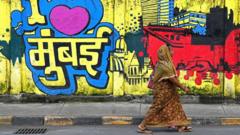In India, urban walking can often feel like an obstacle course for pedestrians. The condition of footpaths across many cities is disheartening, as Arun Pai discovered in Bengaluru, where he started a challenge titled the 'world's longest footpath run.' Participants were invited to walk an 11 km stretch and log various obstacles like hawkers or uneven slabs. Pai, who founded Bangalore Walks, underscores the importance of specifics when addressing footpath issues with local politicians.
This awareness is echoed across urban centers in India, where citizen groups are advocating for more pedestrian-friendly policies. In Delhi, a tour company is promoting cycling and walking, while Mumbai's Walking Project has released a 'pedestrian manifesto' to highlight the dire need for infrastructural change ahead of state elections. Their demands include dedicated hawking zones, better parking, and improved access for vulnerable populations.
Government statistics reveal that nearly 50% of Mumbai's population primarily relies on walking, overshadowing private transportation methods, yet pedestrian safety policies remain insufficient. Recent data shows that pedestrian fatalities rank alarmingly high due to road accidents, with over 10,000 deaths reported in 2022 alone. Activists argue that merely adding speed bumps won't suffice; a comprehensive approach to developing interconnected footpaths is essential.
Research from Chennai showcases positive changes attributed to improved footpaths, which promoted walking as a viable alternative to motorized transport, thereby lowering greenhouse emissions and enhancing mobility for low-income communities. The results indicate that addressing the needs of marginalized groups, such as women and disabled individuals, can foster accessibility and equity in urban planning.
The gap in public awareness about proper pedestrian infrastructure is largely attributed to a lack of exposure to better standards seen internationally. Many tend to view walking as primarily for leisure rather than an essential mode of transport, limiting the conversation around necessary infrastructure to parks and recreational paths.
Experts like Geetam Tiwari emphasize that solving car congestion shouldn't come at the expense of pedestrian safety. She argues for maintaining wider footpaths to facilitate access to public transportation, suggesting a shift in focus that prioritizes pedestrian facilities to ultimately mitigate traffic woes.
It is crucial for the federal government to enforce existing guidelines and encourage states to adopt non-motorized transport policies actively, as only a few cities have made strides in this direction. Advocates insist that enhancing walking infrastructure is not only a matter of urban planning but also aligns with sustainability and social equity goals for India's rapidly growing cities.
Ultimately, as cities continue to evolve, prioritizing pedestrian infrastructure will not only improve the safety and mobility of millions but also contribute positively to urban environments and community well-being.
This awareness is echoed across urban centers in India, where citizen groups are advocating for more pedestrian-friendly policies. In Delhi, a tour company is promoting cycling and walking, while Mumbai's Walking Project has released a 'pedestrian manifesto' to highlight the dire need for infrastructural change ahead of state elections. Their demands include dedicated hawking zones, better parking, and improved access for vulnerable populations.
Government statistics reveal that nearly 50% of Mumbai's population primarily relies on walking, overshadowing private transportation methods, yet pedestrian safety policies remain insufficient. Recent data shows that pedestrian fatalities rank alarmingly high due to road accidents, with over 10,000 deaths reported in 2022 alone. Activists argue that merely adding speed bumps won't suffice; a comprehensive approach to developing interconnected footpaths is essential.
Research from Chennai showcases positive changes attributed to improved footpaths, which promoted walking as a viable alternative to motorized transport, thereby lowering greenhouse emissions and enhancing mobility for low-income communities. The results indicate that addressing the needs of marginalized groups, such as women and disabled individuals, can foster accessibility and equity in urban planning.
The gap in public awareness about proper pedestrian infrastructure is largely attributed to a lack of exposure to better standards seen internationally. Many tend to view walking as primarily for leisure rather than an essential mode of transport, limiting the conversation around necessary infrastructure to parks and recreational paths.
Experts like Geetam Tiwari emphasize that solving car congestion shouldn't come at the expense of pedestrian safety. She argues for maintaining wider footpaths to facilitate access to public transportation, suggesting a shift in focus that prioritizes pedestrian facilities to ultimately mitigate traffic woes.
It is crucial for the federal government to enforce existing guidelines and encourage states to adopt non-motorized transport policies actively, as only a few cities have made strides in this direction. Advocates insist that enhancing walking infrastructure is not only a matter of urban planning but also aligns with sustainability and social equity goals for India's rapidly growing cities.
Ultimately, as cities continue to evolve, prioritizing pedestrian infrastructure will not only improve the safety and mobility of millions but also contribute positively to urban environments and community well-being.

















